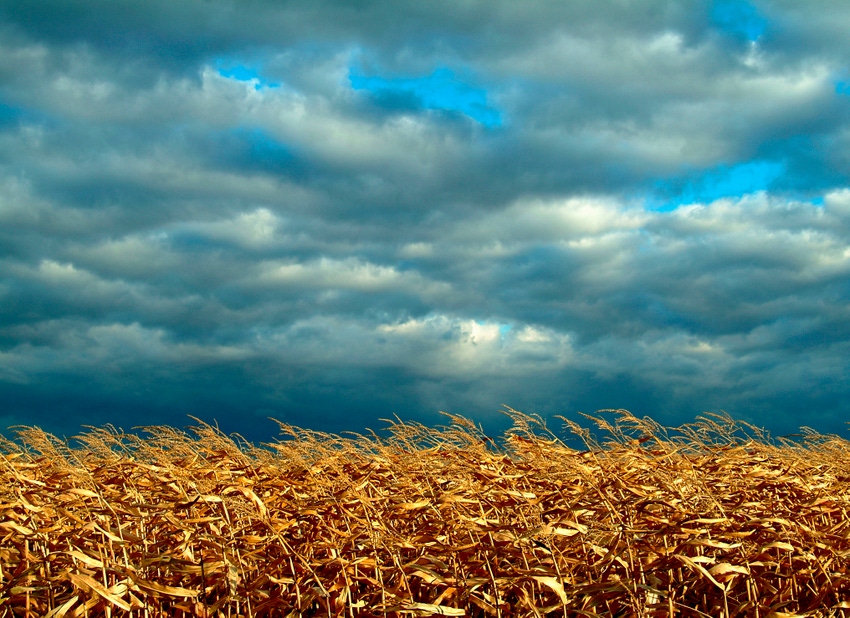
The fall harvest season started later than normal in most areas of the Upper Midwest in 2017, and has incurred further delays due to wetter-than-normal weather during October in many areas. Harvest progress picked up in some areas of the region during the latter portions of the month, but remains well behind average progress. The first three weeks October did feature above-normal temperatures, which aided in the field drydown of corn and soybeans. Some portions of the Midwest received significant rainfall the first half of October, as well as additional rain or snow during the last week of the month, which has greatly delayed harvest progress in many areas.
As of Oct. 23, the weekly USDA Crop Progress Report listed 83% of the soybeans harvested in Minnesota, compared to 5-year average of 93% harvested by that date, and 94% harvested in 2016. Iowa reported 61% of the soybeans harvested on Oct. 23, compared to an average of 81% harvested by that date. The Oct. 23 soybean harvest rate in both Minnesota and Iowa nearly doubled from the preceding week. Nationwide, 70% of the soybeans were harvested by Oct. 23, which is just below the 5-year average of 73% harvested by that date.
According to the Oct. 23 report, only 14% of Minnesota’s corn crop had been harvested, compared to a 5-year average of 55% by that date, and 52% harvested in 2016. Iowa had only 23% of the corn crop harvested by Oct. 23, compared to an average of 55% by that date. Some progress has been made in corn harvest in southern Minnesota and northern Iowa during the final week of October. Nationwide, 38% of the corn crop had been harvested by Oct. 23, compared to an average of 59% typically harvested by that date.
As usual, soybean yields have been highly variable across southern Minnesota and Northern Iowa. Reported whole-field soybean yields of 50-60 bushels per acre have been quite common in many areas of South Central and Southwest Minnesota, with a few yields exceeding those levels. There were some reduced yields in areas that were impacted by severe storms during the 2017 growing season, as well as in fields that were severely impacted by white mold and other soybean diseases. The 2017 soybean yields in many areas have not reached the record soybean yield levels that numerous farm operators experienced in 2016; however, 2017 yields have exceeded the expectations of most producers, given the highly variable growing season in 2017.
Early reports of 2017 corn yields in southern Minnesota have been a pleasant surprise in many areas. There has been some variability in the corn yields, depending on planting date, damage from severe storms and late-season diseases. There have been numerous whole-field yield reports of over 200 bushels per acre in several portions south-central and southwest Minnesota, with slightly lower yields being reported in areas that experienced weather problems during the 2017 growing season. There is potential for increased field and harvest loss in the corn as we get later into harvest season
One piece of good news for all producers regarding the 2017 corn harvest has been the harvest moisture of corn coming out of the field. Most of the corn being harvested in south-central Minnesota in the past week has been at 18-24% moisture, meaning a reduced amount of additional drying is required before the corn is placed in on-farm bins for storage. Corn should be dried to about 15-16% moisture before going into the grain bin for safe storage until next spring or summer. In early October, much of the corn was still at 25-30% moisture, or higher. As we head into November, the field moisture content of the corn is not likely to drop as significantly.
Due to higher-than-expected corn yields and more carryover old-crop corn than normal, some producers are running into a shortage of corn storage space. According to university research, corn that is at a moisture content of 22%, and a grain temperature of 50° F, can be stored in temporary flat storage for approximately 30 days without damage, provided there is an aeration system in place to move air through the corn. At a grain temperature of 40°, the allowable storage time increases to approximately 60 days at 22% grain moisture content, and to about 140 days at 19% moisture. However, the allowable storage time drops to only 12 days at a corn moisture content of 26% moisture and a grain temperature of 50°, and to 35 days at a temperature of 40°. The allowable safe storage time is much shorter if no aeration is available. The University of Minnesota Extension Service has a very good information sheet on grain drying and storage available.
About the Author(s)
You May Also Like






